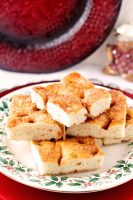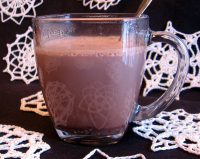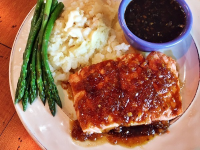TONKOTSU (ȱŠÉª¨, PORK BONE; ) RAMEN RECIPE - FOOD.COM

Tonkotsu (豚骨, "pork bone"; not to be confused with tonkatsu) ramen usually has a cloudy white colored broth. It is similar to the Chinese baitang (白湯) and has a thick broth made from boiling pork bones, fat, and collagen over high heat for many hours, which suffuses the broth with a hearty pork flavor and a creamy consistency that rivals milk or melted butter or gravy (depending on the shop). Found all my raman recipies online also get 5 to 5.5 g Powdered Kansui (alkaline salts) (google for details) it needed for the recipi the ingreediant list wont add it on here for some reason.
Total Time 7 hours 20 minutes
Prep Time 20 minutes
Cook Time 7 hours
Yield 1 cooking pot full, 5 serving(s)
Number Of Ingredients 14
Steps:
- Step 1: Have the butcher separate the pork hock bones.
- Step 2: Rinse well in running water to wash off blood. Boil in large pot for 15 minutes. You want to barely cover the bones with water.
- Step 3: Skim off as much scum as possible as it forms.
- Step 4: Drain in colander and use a brush to remove any bloody meat.
- Step 5: Use a saw and saw halfway down the center of the bones. Then use hammer to break bone.
- Note: I didn’t have to break the bones since my butcher’s pork hocks already had the marrow exposed.
- Step 6: The bones will be filled with marrow. Simmer for several hours until the marrow dissolves out from the bones.
- Step 7: Scum will form at the start. Carefully skim the scum off. On mid flame, maintain a low boil.
- Step 8: After scum has stopped forming, simmer for 6 hours or more. Add more water if the water level drops.
- Step 9: Making the noodles. After measuring out the ingredients, mix the flour and kansui together, then add the water. It may feel as if the amount of water is insufficient. This is normal.
- Step 10: Mix in bowl until a mealy consistency is achieved.
- Step 11: The dough will be very stiff. Use you body weight to form the dough into a ball.
- Step 12: Transfer to kneading surface and knead. Knead vigorously for 10 minutes. It is ok if the dough cracks or does not knead together well.
- Step 13: Form into ball, cover with plastic wrap and allow to rest in the refrigerator for at least 30 minutes. Make sure that the dough does not dry out.
- Step 14: While the dough rests, prepare the char siu. Brown the meat in a pan and then simmer in a pot for 2 hours in a sauce made from the remaining ingredients. Allow to cool in the pot.
- Step 15: After the dough has rested, roll the dough out with a rolling pin to a thickness of 5 mm and then insert into pasta machine. Start out with the highest thickness and then continue on the lower settings until the desired thickness is achieved.
- Step 16: If a pasta machine is not used, roll out the dough to the desired thickness with the rolling pin. Take into account that the noodles will expand 1.3 times when boiled.
- Step 17: The dough will not be that sticky, so a small amount of flour or potato (or corn) starch is sufficient for flouring. (Note that the recipe only shows the noodles being cut by a pasta machine and does not mention hand cutting).
- Step 18: A wooden box is best for storing the noodles, but if one is not available, use a metal tray lined with wax paper (to prevent sticking) and store in the refrigerator.
- Step 19: 2 hours after the pork bones have started simmering, the soup should become progressively white and cloudy. If tasted at this stage, the soup will not taste good since it will still have a raw flavor.
- Step 20: After the soup has simmered for 6 hours, The inside of the bones should now be empty and the soup should have a rich smell just like a ramen place.
- The stock is rich. It exactly like the picture, it’s not a clear stock at all. Just remember that it won’t have much taste right now because there’s no salt. But don’t adjust the seasoning until the end of the recipe because you’re adding soy sauce to the ramen base.
- Step 21: The char siu should be a nice amber color. Slice with care since it will be very tender and tend to fall apart.
- Step 22: Any leftovers can be eaten with beer.
- LOL But I will add that if you ever have trouble slicing soft pork, chill the whole piece in the refrigerator until cold, and it makes slicing easier. Reheating is easy, in either the microwave or oven, even stove top.
- Step 23: It’s time to put everything together. Since boiling time can differ, boil the noodles to each person’s preference. For people who like curly noodles, firmly squeeze the noodles until the desired effect is achieved.
- Step 24: Warm the bowl, and add the char siu sauce and salt for flavor. Use sparingly at first and then add more if desired.
- Step 25: I prefer to boil the noodles for 1 1/2 to 2 minutes. Your rich and hearty tonkotsu ramen is complete.
- Notes:.
- Okay, because final assembly occurred, I prepared some soy sauce marinated eggs the night before.
- Here’s what I did:.
- Ingredients:.
- 12 eggs in shells.
- Diced pork hock meat (leftovers from recipe above) 1 lb.
- 3 green onions cut into 1 inch pieces.
- 1 thumb sized piece of ginger sliced.
- 2 large cloves of garlic sliced.
- 1/2 cup soy sauce.
- 2 Tablespoons cooking wine/sake/sherry.
- 2 Tablespoons Sugar.
- 1/2 cup water.
- Step 1: Bring a pot of water to a rolling boil. (Using a small thumb tack, I prick a pin hole in the base (fat end) of every egg, but that’s not necessary.) The the water is at a full boil, I put the eggs inches The water should cover the eggs. Wait for the water to come back to a full boil, and time for 7 minutes. (9 minutes will give you a fully hard boiled egg. 7 minutes is a very soft boiled egg.) Drain the pot and eggs and plunge the eggs in ice water to stop cooking. This also makes the shells a bit easier to peel.
- Step 2: In a small pot, saute pork, garlic, onions, and ginger until slightly browned. Add soy sauce, cooking alcohol, sugar, water and simmer for 10 minutes. Until pork is cooked through and flavors meld. Remove from stove. Remove pork to eat separately. Pour everything else into a bowl large enough to hold marinade and eggs.
- Step 3: Carefully, peel the eggs, and place in marinade. Try to make sure the marinade covers all of the eggs. If not, try transferring the sauce into a large ZipLock bag, and place the eggs in the bag and seal. Place the bag in a bowl, and put everything in the refrigerator overnight. Or at least for a few hours.
- Soy sauce eggs ready!
- I usually cut them in half before adding them to the ramen bowl. You can reheat the eggs quickly in the stock before you assemble the ramen.
Nutrition Facts : Calories 426.8, FatContent 1.1, SaturatedFatContent 0.2, CholesterolContent 0, SodiumContent 750.5, CarbohydrateContent 89.5, FiberContent 4.3, SugarContent 5.4, ProteinContent 12.8
TONKOTSU (ȱŠÉª¨, PORK BONE; ) RAMEN RECIPE - FOOD.COM

Tonkotsu (豚骨, "pork bone"; not to be confused with tonkatsu) ramen usually has a cloudy white colored broth. It is similar to the Chinese baitang (白湯) and has a thick broth made from boiling pork bones, fat, and collagen over high heat for many hours, which suffuses the broth with a hearty pork flavor and a creamy consistency that rivals milk or melted butter or gravy (depending on the shop). Found all my raman recipies online also get 5 to 5.5 g Powdered Kansui (alkaline salts) (google for details) it needed for the recipi the ingreediant list wont add it on here for some reason.
Total Time 7 hours 20 minutes
Prep Time 20 minutes
Cook Time 7 hours
Yield 1 cooking pot full, 5 serving(s)
Number Of Ingredients 14
Steps:
- Step 1: Have the butcher separate the pork hock bones.
- Step 2: Rinse well in running water to wash off blood. Boil in large pot for 15 minutes. You want to barely cover the bones with water.
- Step 3: Skim off as much scum as possible as it forms.
- Step 4: Drain in colander and use a brush to remove any bloody meat.
- Step 5: Use a saw and saw halfway down the center of the bones. Then use hammer to break bone.
- Note: I didn’t have to break the bones since my butcher’s pork hocks already had the marrow exposed.
- Step 6: The bones will be filled with marrow. Simmer for several hours until the marrow dissolves out from the bones.
- Step 7: Scum will form at the start. Carefully skim the scum off. On mid flame, maintain a low boil.
- Step 8: After scum has stopped forming, simmer for 6 hours or more. Add more water if the water level drops.
- Step 9: Making the noodles. After measuring out the ingredients, mix the flour and kansui together, then add the water. It may feel as if the amount of water is insufficient. This is normal.
- Step 10: Mix in bowl until a mealy consistency is achieved.
- Step 11: The dough will be very stiff. Use you body weight to form the dough into a ball.
- Step 12: Transfer to kneading surface and knead. Knead vigorously for 10 minutes. It is ok if the dough cracks or does not knead together well.
- Step 13: Form into ball, cover with plastic wrap and allow to rest in the refrigerator for at least 30 minutes. Make sure that the dough does not dry out.
- Step 14: While the dough rests, prepare the char siu. Brown the meat in a pan and then simmer in a pot for 2 hours in a sauce made from the remaining ingredients. Allow to cool in the pot.
- Step 15: After the dough has rested, roll the dough out with a rolling pin to a thickness of 5 mm and then insert into pasta machine. Start out with the highest thickness and then continue on the lower settings until the desired thickness is achieved.
- Step 16: If a pasta machine is not used, roll out the dough to the desired thickness with the rolling pin. Take into account that the noodles will expand 1.3 times when boiled.
- Step 17: The dough will not be that sticky, so a small amount of flour or potato (or corn) starch is sufficient for flouring. (Note that the recipe only shows the noodles being cut by a pasta machine and does not mention hand cutting).
- Step 18: A wooden box is best for storing the noodles, but if one is not available, use a metal tray lined with wax paper (to prevent sticking) and store in the refrigerator.
- Step 19: 2 hours after the pork bones have started simmering, the soup should become progressively white and cloudy. If tasted at this stage, the soup will not taste good since it will still have a raw flavor.
- Step 20: After the soup has simmered for 6 hours, The inside of the bones should now be empty and the soup should have a rich smell just like a ramen place.
- The stock is rich. It exactly like the picture, it’s not a clear stock at all. Just remember that it won’t have much taste right now because there’s no salt. But don’t adjust the seasoning until the end of the recipe because you’re adding soy sauce to the ramen base.
- Step 21: The char siu should be a nice amber color. Slice with care since it will be very tender and tend to fall apart.
- Step 22: Any leftovers can be eaten with beer.
- LOL But I will add that if you ever have trouble slicing soft pork, chill the whole piece in the refrigerator until cold, and it makes slicing easier. Reheating is easy, in either the microwave or oven, even stove top.
- Step 23: It’s time to put everything together. Since boiling time can differ, boil the noodles to each person’s preference. For people who like curly noodles, firmly squeeze the noodles until the desired effect is achieved.
- Step 24: Warm the bowl, and add the char siu sauce and salt for flavor. Use sparingly at first and then add more if desired.
- Step 25: I prefer to boil the noodles for 1 1/2 to 2 minutes. Your rich and hearty tonkotsu ramen is complete.
- Notes:.
- Okay, because final assembly occurred, I prepared some soy sauce marinated eggs the night before.
- Here’s what I did:.
- Ingredients:.
- 12 eggs in shells.
- Diced pork hock meat (leftovers from recipe above) 1 lb.
- 3 green onions cut into 1 inch pieces.
- 1 thumb sized piece of ginger sliced.
- 2 large cloves of garlic sliced.
- 1/2 cup soy sauce.
- 2 Tablespoons cooking wine/sake/sherry.
- 2 Tablespoons Sugar.
- 1/2 cup water.
- Step 1: Bring a pot of water to a rolling boil. (Using a small thumb tack, I prick a pin hole in the base (fat end) of every egg, but that’s not necessary.) The the water is at a full boil, I put the eggs inches The water should cover the eggs. Wait for the water to come back to a full boil, and time for 7 minutes. (9 minutes will give you a fully hard boiled egg. 7 minutes is a very soft boiled egg.) Drain the pot and eggs and plunge the eggs in ice water to stop cooking. This also makes the shells a bit easier to peel.
- Step 2: In a small pot, saute pork, garlic, onions, and ginger until slightly browned. Add soy sauce, cooking alcohol, sugar, water and simmer for 10 minutes. Until pork is cooked through and flavors meld. Remove from stove. Remove pork to eat separately. Pour everything else into a bowl large enough to hold marinade and eggs.
- Step 3: Carefully, peel the eggs, and place in marinade. Try to make sure the marinade covers all of the eggs. If not, try transferring the sauce into a large ZipLock bag, and place the eggs in the bag and seal. Place the bag in a bowl, and put everything in the refrigerator overnight. Or at least for a few hours.
- Soy sauce eggs ready!
- I usually cut them in half before adding them to the ramen bowl. You can reheat the eggs quickly in the stock before you assemble the ramen.
Nutrition Facts : Calories 426.8, FatContent 1.1, SaturatedFatContent 0.2, CholesterolContent 0, SodiumContent 750.5, CarbohydrateContent 89.5, FiberContent 4.3, SugarContent 5.4, ProteinContent 12.8
TONKOTSU RAMEN RECIPE: HOW TO MAKE TONKOTSU RAMEN - 2022 ...
Apr 29, 2021 · Tonkotsu Ramen Recipe: How to Make Tonkotsu Ramen - 2021 - MasterClass. Tonkotsu ramen is a hearty pork-based soup that has become one of the most popular varieties of Japanese ramen. Learn how to make it at home, with a rich, long-simmering stock.
From masterclass.com
From masterclass.com
See details
HOW TO MAKE TONKOTSU RAMEN? | RAMEN HERO
From ramenhero.com
See details
TONKOTSU RAMEN RECIPE - CREAMY JAPANESE PORK BONE BROTH ...
From norecipes.com
See details
TONKOTSU RAMEN SOUP BASE — EASYPEASYJAPANESEY
Apr 22, 2016 · Start making the Tonkotsu Soup: In a separate pot of boiling water, blanch the chicken feet, drain, and then add them to the pressure cooker along with the pork knuckles or trotters and the potatoes. Cover with up to 5 quarts (4.7 L) water, making sure the total volume of water and food combined does not exceed half of the pot.
From easypeasyjapanesey.com
From easypeasyjapanesey.com
See details
TONKOTSU RAMEN QUICK RECIPE TO WARM YOUR SOUL | FOODIE ...
May 11, 2020 · Make Tonkotsu Broth Bring 8 cups of water to a boil in a large pot. Add tonkotsu soup base and stir until dissolved. Add kikurage mushrooms, reduce heat to low, cover, and simmer for at least 20-25 minutes as you continue with the recipe.
From thefoodieglobetrotter.com
From thefoodieglobetrotter.com
See details
HOMEMADE TONKOTSU RAMEN - HONEST COOKING - RECIPES
Apr 20, 2015 · To make mayu (black oil), over medium low heat, fry 5 cloves of peeled, finely diced garlic in 2 tablespoons of any neutral tasting oil and 1 tablespoon sesame oil. Fry until garlic turns black. Place all in a blender and blend until smooth. I marinate the eggs and the chashu pork at the same.
From honestcooking.com
From honestcooking.com
See details
RICH AND CREAMY TONKOTSU RAMEN BROTH RECIPE
Feb 28, 2012 · Once broth is ready, cook over high heat until reduced to around 3 quarts. Strain through a fine mesh strainer into a clean pot. Discard solids. For an even cleaner soup, strain again through a chinois or a fine mesh strainer lined with several layers of cheese cloth. Skim liquid fat from top with a ladle and discard.
From seriouseats.com
From seriouseats.com
See details
HOW TO MAKE THE BEST TONKOTSU RAMEN FROM SCRATCH
Dec 02, 2021 · What is tonkotsu ramen? Tonkotsu in Japanese means pork bones. Tonkotsu ramen means pork bones soup ramen. That said, the main ingredient of this recipe is pork bones with an extra of pork fat. Here are the break down of this Japanese ramen recipe: Ramen noodle - can be fresh, frozen or dry. The homemade authentic ramen broth includes two parts:
From cookmorphosis.com
From cookmorphosis.com
See details
TONKOTSU RAMEN RECIPE : SBS FOOD
Place on a wire rack set inside a roasting pan and fill pan with enough water to reach 2 cm up the sides. Add sake. Roast pork for 1 hour or until tender and cooked through. Remove from oven and ...
From sbs.com.au
From sbs.com.au
See details
HOW TO MAKE TONKOTSU RAMEN – ADAMLIAW.COM
Apr 16, 2020 · Transfer to a saucepan and heat over very low heat for about 1 hour until just warm to the touch. Remove the seafood and measure the volume of dashi produced. Add salt in the ratio of 1:5 (i.e. 100 g salt for 500 g dashi) and stir over heat until the salt is fully dissolved. Add the vinegar and set aside.
From adamliaw.com
From adamliaw.com
See details
TONKOTSU RAMEN - RAMEN MAKING CHAPTER 4 - OMNIVORE'S COOKBOOK
Jun 21, 2020 · Instructions. Bring a large pot of water to boil, add noodles and boil according to instruction. While boiling noodles, add pork stock and water into a small pot and heat till bringing a boil, add chicken stock, soy sauce, wine and salt to taste, boil for 1 more minute. Turn off heat, add sesame oil.
From omnivorescookbook.com
From omnivorescookbook.com
See details
HOW TO MAKE HAKATA TONKOTSU RAMEN? | RAMEN HERO
Oct 17, 2021 · Method: Add 400g of flour to a mixing bowl. In a separate bowl, mix the kansui and salt in to the water. Stir the kansui mixture into the flour. Place into resealable bag and press flat. Rest the dough for 40 minutes. Cut into thin noodles.
From ramenhero.com
From ramenhero.com
See details
HAKATA TONKOTSU PORK STOCK RAMEN RECIPE - JAPAN CENTRE
Bring the tonkotsu soup to a gentle boil and simmer (be careful not to simmer off too much liquid). While the stock is coming to the boil, cut the nitamago egg in half and the char siu pork into 6 even slices (3 for each ramen) and chop your spring onion. In a non-stick frying pan, gently brown each side of the sliced char siu pork.
From japancentre.com
From japancentre.com
See details
TONKOTSU MISO RAMEN - NO RECIPES
Steps. In a medium saucepan, heat the Tonkotsu Base. Combine the miso, tahini, sesame oil, and garlic in small bowl, then whisk in the water. Pour this mixture into the hot Tonkotsu Base and whisk together. When it is smooth and creamy and there are no chunks left, add the minced pork fat and whisk it in. Taste for salt and add salt to taste.
From norecipes.com
From norecipes.com
See details
40 BEST RAMEN TOPPINGS FOR YOUR HOMEMADE NOODLE SOUP ...
Jun 03, 2021 · The best tonkotsu recipe would most likely call for this ingredient as a garnish. Although, aonegi (or chopped green onion) would be able to elevate any kind of good ramen recipe. This vegetable adds an aromatic quality, as well as a necessary kick of heat that isn’t overwhelming to Japanese ramen dishes.
From recipes.net
From recipes.net
See details
10 BEST RAMEN SOUP WITH RECIPES | YUMMLY
Jan 12, 2022 · The Best Ramen Soup Noble Tandem. tomato paste, bok choy, maple syrup, limes, coriander, minced garlic and 9 more.
From yummly.com
From yummly.com
See details
EASY TONKOTSU RAMEN RECIPE – SOUS CHEF UK
Method for making the tonkotsu ramen stock (8-10 hours) Place the chicken wings and rolled pork belly in a stock pot and cover with 4 litres of cold water. Bring to the boil. Keep a close eye on the pot for the first 20-30 minutes of cooking, move the bones around regularly, and skim off the foam rises to the surface.
From souschef.co.uk
From souschef.co.uk
See details
PORK & CABBAGE ‘TONKOTSU’ RAMEN SOUP RECIPE BY HIROKO ...
Aug 29, 2021 · Great recipe for Pork & Cabbage ‘Tonkotsu’ Ramen Soup. More and more Japanese Instant Ramen Noodle products are becoming available in Australia. One of the most popular soup flavours is ‘Tonkotsu’. Do you know the Japanese word ‘Tonkotsu’ means Pork Bones? The soup is based on Pork Bone...
From cookpad.com
From cookpad.com
See details
TONKOTSU RAMEN RECIPE | RECIPE | RAMEN RECIPES, TONKOTSU ...
Mar 21, 2016 - Tonkotsu Ramen Recipe An ode to Ramen I love Ramen. Especially Tonkotsu Ramen. It is one of my ultimate comfort foods. The milky, savory broth. The slurpy noodles. The yolky egg and the crispy cha
From pinterest.com
From pinterest.com
See details
TONKOTSU SHIO RAMEN AND CHASHU PORK - FOREVER ...
Chashu Pork. Preheat the oven to 250°F. Place all of the ingredients in a large, heavy-bottomed, oven safe pot and bring to a gentle boil over medium heat. When the mix comes to boil, cover with the lid and place in the oven and cook for minimum 4 hours, up to 6, flipping pork occasionally. The pork should be super tender.
From forevernomday.com
From forevernomday.com
See details






























